Action Plan: Improving Safety and Quality in HIV Health Literacy
VerifiedAdded on 2023/01/17
|10
|1952
|82
Report
AI Summary
This report outlines a comprehensive action plan aimed at improving language and cultural health literacy for people living with HIV, with a focus on healthcare providers and professional care teams. The plan addresses the critical link between low health literacy and poor patient outcomes, emphasizing the need for culturally sensitive communication and understanding. The action plan includes specific goals, strategies, resource allocation, and methods for overcoming barriers such as resource limitations and resistance to change. Key strategies involve prioritizing resource allocation, mapping the cause and effect of different plan components, training staff, and developing effective communication plans. The report also details the implementation process, including awareness campaigns, staff training, and ongoing monitoring and evaluation using various data collection methods. The evaluation section discusses both progress and outcome evaluations, and how the results will be used to refine and improve the plan, ensuring its effectiveness in enhancing the quality of care for HIV patients. References are provided to support the information in the report.
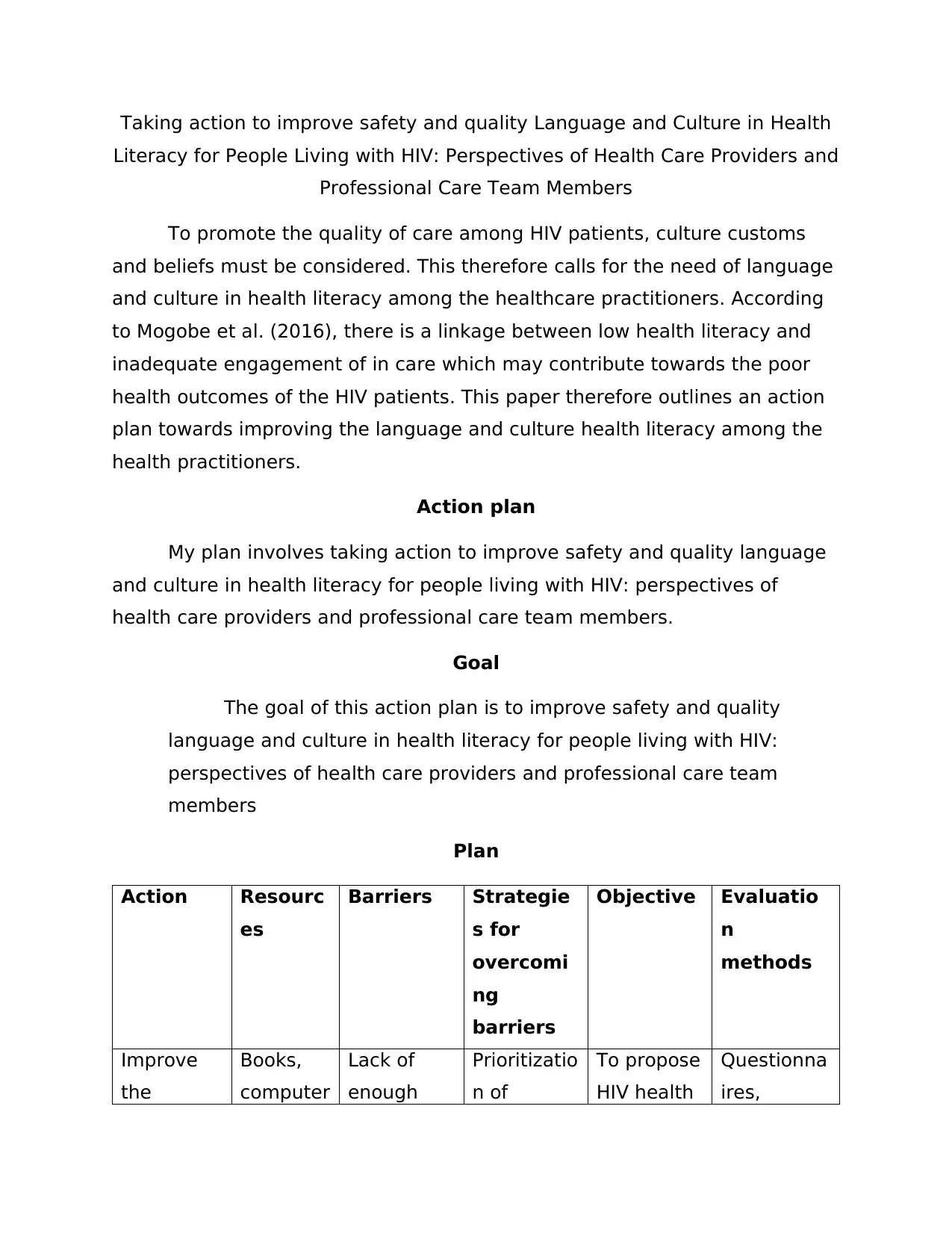
Taking action to improve safety and quality Language and Culture in Health
Literacy for People Living with HIV: Perspectives of Health Care Providers and
Professional Care Team Members
To promote the quality of care among HIV patients, culture customs
and beliefs must be considered. This therefore calls for the need of language
and culture in health literacy among the healthcare practitioners. According
to Mogobe et al. (2016), there is a linkage between low health literacy and
inadequate engagement of in care which may contribute towards the poor
health outcomes of the HIV patients. This paper therefore outlines an action
plan towards improving the language and culture health literacy among the
health practitioners.
Action plan
My plan involves taking action to improve safety and quality language
and culture in health literacy for people living with HIV: perspectives of
health care providers and professional care team members.
Goal
The goal of this action plan is to improve safety and quality
language and culture in health literacy for people living with HIV:
perspectives of health care providers and professional care team
members
Plan
Action Resourc
es
Barriers Strategie
s for
overcomi
ng
barriers
Objective Evaluatio
n
methods
Improve
the
Books,
computer
Lack of
enough
Prioritizatio
n of
To propose
HIV health
Questionna
ires,
Literacy for People Living with HIV: Perspectives of Health Care Providers and
Professional Care Team Members
To promote the quality of care among HIV patients, culture customs
and beliefs must be considered. This therefore calls for the need of language
and culture in health literacy among the healthcare practitioners. According
to Mogobe et al. (2016), there is a linkage between low health literacy and
inadequate engagement of in care which may contribute towards the poor
health outcomes of the HIV patients. This paper therefore outlines an action
plan towards improving the language and culture health literacy among the
health practitioners.
Action plan
My plan involves taking action to improve safety and quality language
and culture in health literacy for people living with HIV: perspectives of
health care providers and professional care team members.
Goal
The goal of this action plan is to improve safety and quality
language and culture in health literacy for people living with HIV:
perspectives of health care providers and professional care team
members
Plan
Action Resourc
es
Barriers Strategie
s for
overcomi
ng
barriers
Objective Evaluatio
n
methods
Improve
the
Books,
computer
Lack of
enough
Prioritizatio
n of
To propose
HIV health
Questionna
ires,
Paraphrase This Document
Need a fresh take? Get an instant paraphrase of this document with our AI Paraphraser
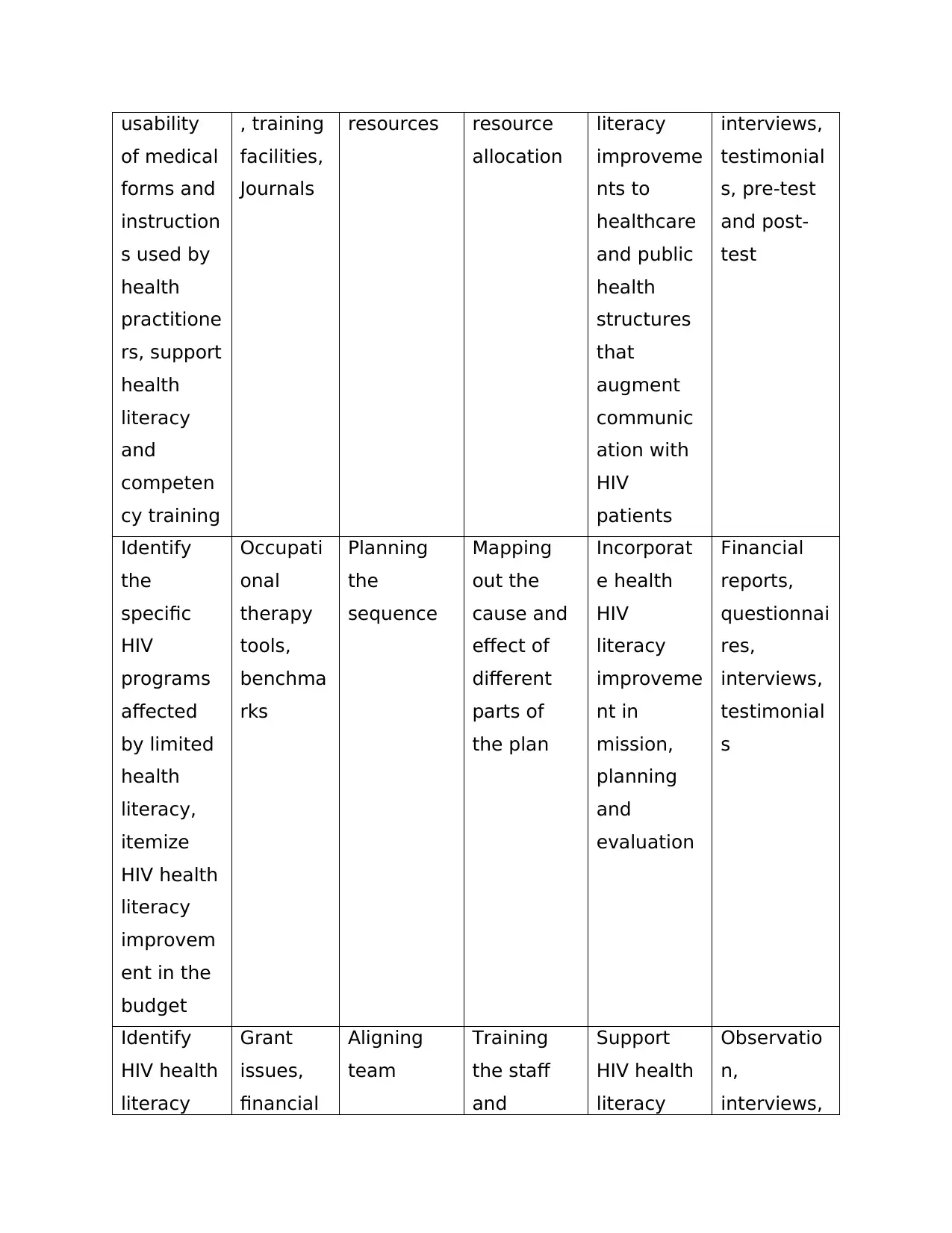
usability
of medical
forms and
instruction
s used by
health
practitione
rs, support
health
literacy
and
competen
cy training
, training
facilities,
Journals
resources resource
allocation
literacy
improveme
nts to
healthcare
and public
health
structures
that
augment
communic
ation with
HIV
patients
interviews,
testimonial
s, pre-test
and post-
test
Identify
the
specific
HIV
programs
affected
by limited
health
literacy,
itemize
HIV health
literacy
improvem
ent in the
budget
Occupati
onal
therapy
tools,
benchma
rks
Planning
the
sequence
Mapping
out the
cause and
effect of
different
parts of
the plan
Incorporat
e health
HIV
literacy
improveme
nt in
mission,
planning
and
evaluation
Financial
reports,
questionnai
res,
interviews,
testimonial
s
Identify
HIV health
literacy
Grant
issues,
financial
Aligning
team
Training
the staff
and
Support
HIV health
literacy
Observatio
n,
interviews,
of medical
forms and
instruction
s used by
health
practitione
rs, support
health
literacy
and
competen
cy training
, training
facilities,
Journals
resources resource
allocation
literacy
improveme
nts to
healthcare
and public
health
structures
that
augment
communic
ation with
HIV
patients
interviews,
testimonial
s, pre-test
and post-
test
Identify
the
specific
HIV
programs
affected
by limited
health
literacy,
itemize
HIV health
literacy
improvem
ent in the
budget
Occupati
onal
therapy
tools,
benchma
rks
Planning
the
sequence
Mapping
out the
cause and
effect of
different
parts of
the plan
Incorporat
e health
HIV
literacy
improveme
nt in
mission,
planning
and
evaluation
Financial
reports,
questionnai
res,
interviews,
testimonial
s
Identify
HIV health
literacy
Grant
issues,
financial
Aligning
team
Training
the staff
and
Support
HIV health
literacy
Observatio
n,
interviews,

improvem
ent in
grants and
contracts,
incorporat
e HIV
health
literacy in
training
anorientai
on
reports members stakeholde
rs
research,
evaluation,
training
and
practice
reports,
questionnai
res,
feedback
forms
Identify
the
specific
target
health
care
providers,
acknowled
ge and
respect
cultural
difference
s, use
principles
which are
designed
towards
the
specific
healthcare
Resistance
to change
Developing
a logical
strategy
map
Direct
developme
ntal
procedure,
and result
assessmen
t to plan
and survey
materials
and assets
Questionna
ires,
interviews,
Feedback
forms,
testing the
target
population
ent in
grants and
contracts,
incorporat
e HIV
health
literacy in
training
anorientai
on
reports members stakeholde
rs
research,
evaluation,
training
and
practice
reports,
questionnai
res,
feedback
forms
Identify
the
specific
target
health
care
providers,
acknowled
ge and
respect
cultural
difference
s, use
principles
which are
designed
towards
the
specific
healthcare
Resistance
to change
Developing
a logical
strategy
map
Direct
developme
ntal
procedure,
and result
assessmen
t to plan
and survey
materials
and assets
Questionna
ires,
interviews,
Feedback
forms,
testing the
target
population
⊘ This is a preview!⊘
Do you want full access?
Subscribe today to unlock all pages.

Trusted by 1+ million students worldwide
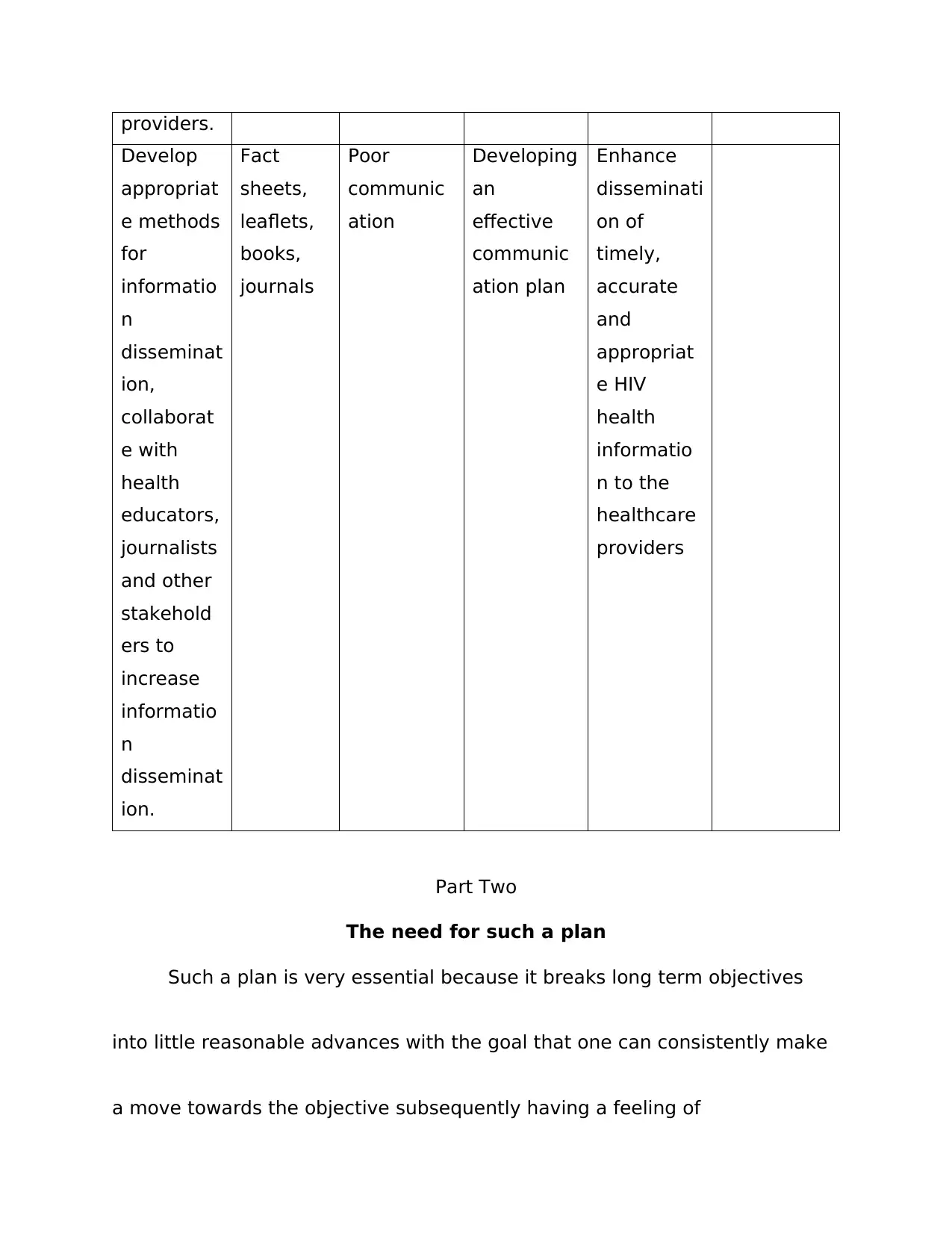
providers.
Develop
appropriat
e methods
for
informatio
n
disseminat
ion,
collaborat
e with
health
educators,
journalists
and other
stakehold
ers to
increase
informatio
n
disseminat
ion.
Fact
sheets,
leaflets,
books,
journals
Poor
communic
ation
Developing
an
effective
communic
ation plan
Enhance
disseminati
on of
timely,
accurate
and
appropriat
e HIV
health
informatio
n to the
healthcare
providers
Part Two
The need for such a plan
Such a plan is very essential because it breaks long term objectives
into little reasonable advances with the goal that one can consistently make
a move towards the objective subsequently having a feeling of
Develop
appropriat
e methods
for
informatio
n
disseminat
ion,
collaborat
e with
health
educators,
journalists
and other
stakehold
ers to
increase
informatio
n
disseminat
ion.
Fact
sheets,
leaflets,
books,
journals
Poor
communic
ation
Developing
an
effective
communic
ation plan
Enhance
disseminati
on of
timely,
accurate
and
appropriat
e HIV
health
informatio
n to the
healthcare
providers
Part Two
The need for such a plan
Such a plan is very essential because it breaks long term objectives
into little reasonable advances with the goal that one can consistently make
a move towards the objective subsequently having a feeling of
Paraphrase This Document
Need a fresh take? Get an instant paraphrase of this document with our AI Paraphraser
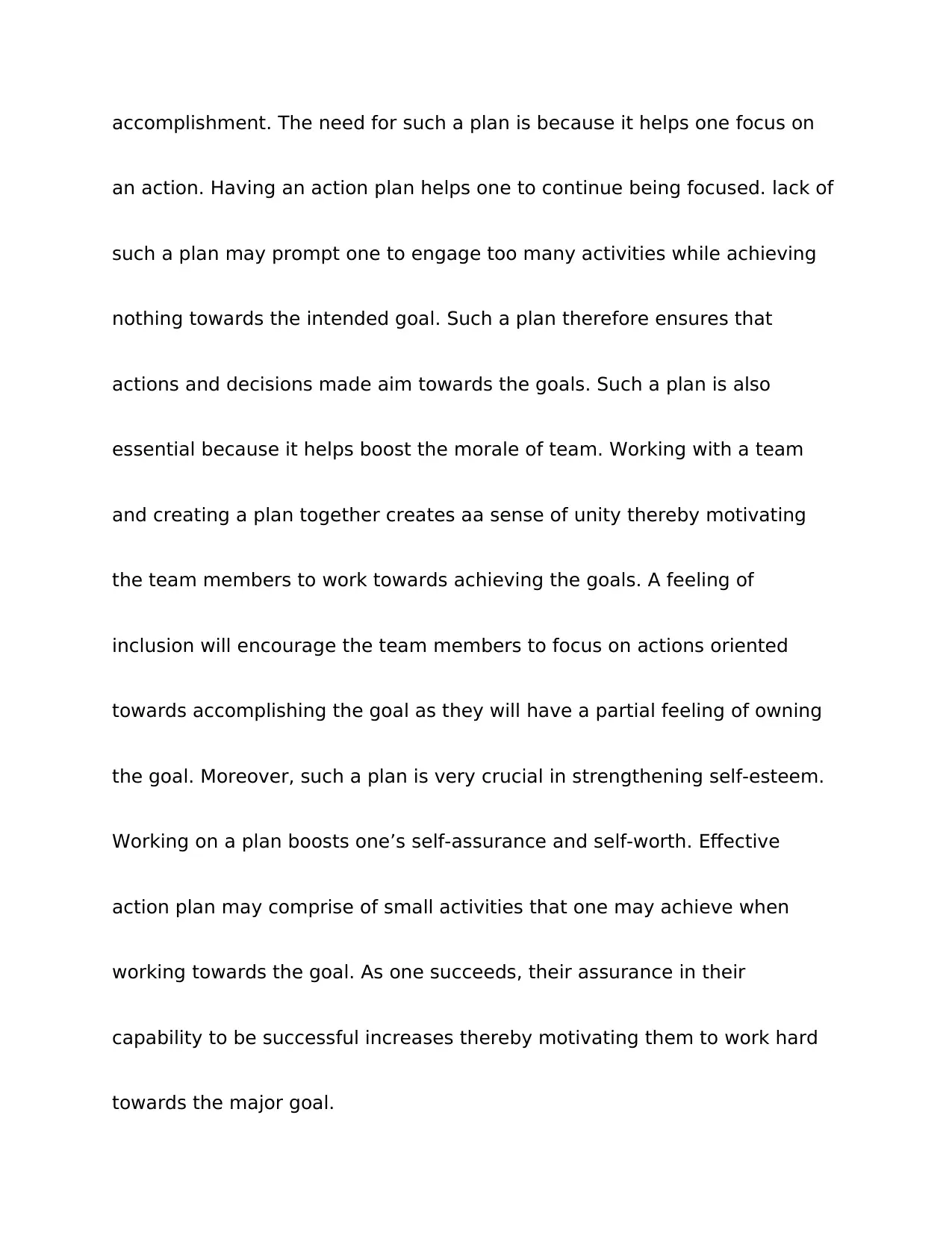
accomplishment. The need for such a plan is because it helps one focus on
an action. Having an action plan helps one to continue being focused. lack of
such a plan may prompt one to engage too many activities while achieving
nothing towards the intended goal. Such a plan therefore ensures that
actions and decisions made aim towards the goals. Such a plan is also
essential because it helps boost the morale of team. Working with a team
and creating a plan together creates aa sense of unity thereby motivating
the team members to work towards achieving the goals. A feeling of
inclusion will encourage the team members to focus on actions oriented
towards accomplishing the goal as they will have a partial feeling of owning
the goal. Moreover, such a plan is very crucial in strengthening self-esteem.
Working on a plan boosts one’s self-assurance and self-worth. Effective
action plan may comprise of small activities that one may achieve when
working towards the goal. As one succeeds, their assurance in their
capability to be successful increases thereby motivating them to work hard
towards the major goal.
an action. Having an action plan helps one to continue being focused. lack of
such a plan may prompt one to engage too many activities while achieving
nothing towards the intended goal. Such a plan therefore ensures that
actions and decisions made aim towards the goals. Such a plan is also
essential because it helps boost the morale of team. Working with a team
and creating a plan together creates aa sense of unity thereby motivating
the team members to work towards achieving the goals. A feeling of
inclusion will encourage the team members to focus on actions oriented
towards accomplishing the goal as they will have a partial feeling of owning
the goal. Moreover, such a plan is very crucial in strengthening self-esteem.
Working on a plan boosts one’s self-assurance and self-worth. Effective
action plan may comprise of small activities that one may achieve when
working towards the goal. As one succeeds, their assurance in their
capability to be successful increases thereby motivating them to work hard
towards the major goal.
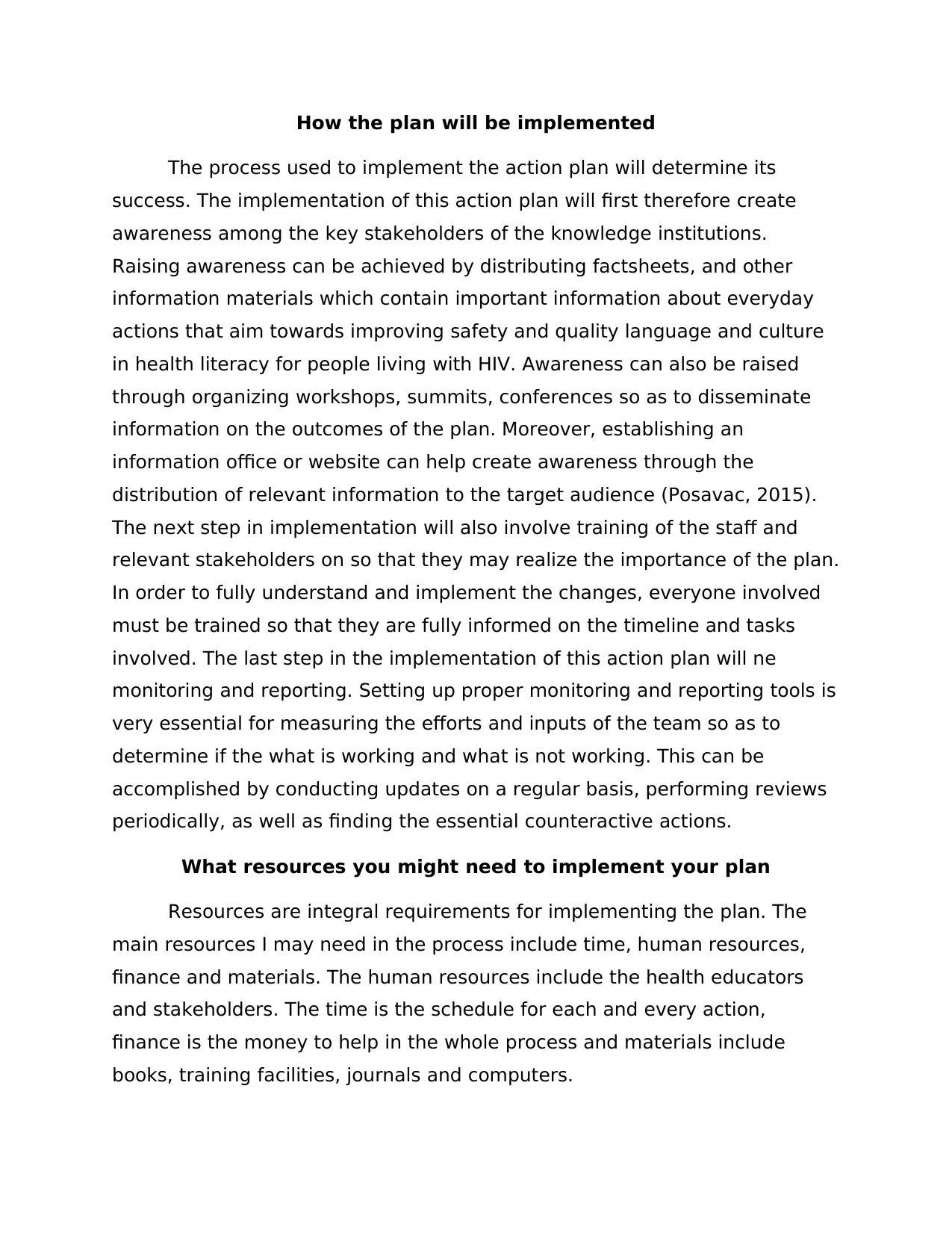
How the plan will be implemented
The process used to implement the action plan will determine its
success. The implementation of this action plan will first therefore create
awareness among the key stakeholders of the knowledge institutions.
Raising awareness can be achieved by distributing factsheets, and other
information materials which contain important information about everyday
actions that aim towards improving safety and quality language and culture
in health literacy for people living with HIV. Awareness can also be raised
through organizing workshops, summits, conferences so as to disseminate
information on the outcomes of the plan. Moreover, establishing an
information office or website can help create awareness through the
distribution of relevant information to the target audience (Posavac, 2015).
The next step in implementation will also involve training of the staff and
relevant stakeholders on so that they may realize the importance of the plan.
In order to fully understand and implement the changes, everyone involved
must be trained so that they are fully informed on the timeline and tasks
involved. The last step in the implementation of this action plan will ne
monitoring and reporting. Setting up proper monitoring and reporting tools is
very essential for measuring the efforts and inputs of the team so as to
determine if the what is working and what is not working. This can be
accomplished by conducting updates on a regular basis, performing reviews
periodically, as well as finding the essential counteractive actions.
What resources you might need to implement your plan
Resources are integral requirements for implementing the plan. The
main resources I may need in the process include time, human resources,
finance and materials. The human resources include the health educators
and stakeholders. The time is the schedule for each and every action,
finance is the money to help in the whole process and materials include
books, training facilities, journals and computers.
The process used to implement the action plan will determine its
success. The implementation of this action plan will first therefore create
awareness among the key stakeholders of the knowledge institutions.
Raising awareness can be achieved by distributing factsheets, and other
information materials which contain important information about everyday
actions that aim towards improving safety and quality language and culture
in health literacy for people living with HIV. Awareness can also be raised
through organizing workshops, summits, conferences so as to disseminate
information on the outcomes of the plan. Moreover, establishing an
information office or website can help create awareness through the
distribution of relevant information to the target audience (Posavac, 2015).
The next step in implementation will also involve training of the staff and
relevant stakeholders on so that they may realize the importance of the plan.
In order to fully understand and implement the changes, everyone involved
must be trained so that they are fully informed on the timeline and tasks
involved. The last step in the implementation of this action plan will ne
monitoring and reporting. Setting up proper monitoring and reporting tools is
very essential for measuring the efforts and inputs of the team so as to
determine if the what is working and what is not working. This can be
accomplished by conducting updates on a regular basis, performing reviews
periodically, as well as finding the essential counteractive actions.
What resources you might need to implement your plan
Resources are integral requirements for implementing the plan. The
main resources I may need in the process include time, human resources,
finance and materials. The human resources include the health educators
and stakeholders. The time is the schedule for each and every action,
finance is the money to help in the whole process and materials include
books, training facilities, journals and computers.
⊘ This is a preview!⊘
Do you want full access?
Subscribe today to unlock all pages.

Trusted by 1+ million students worldwide
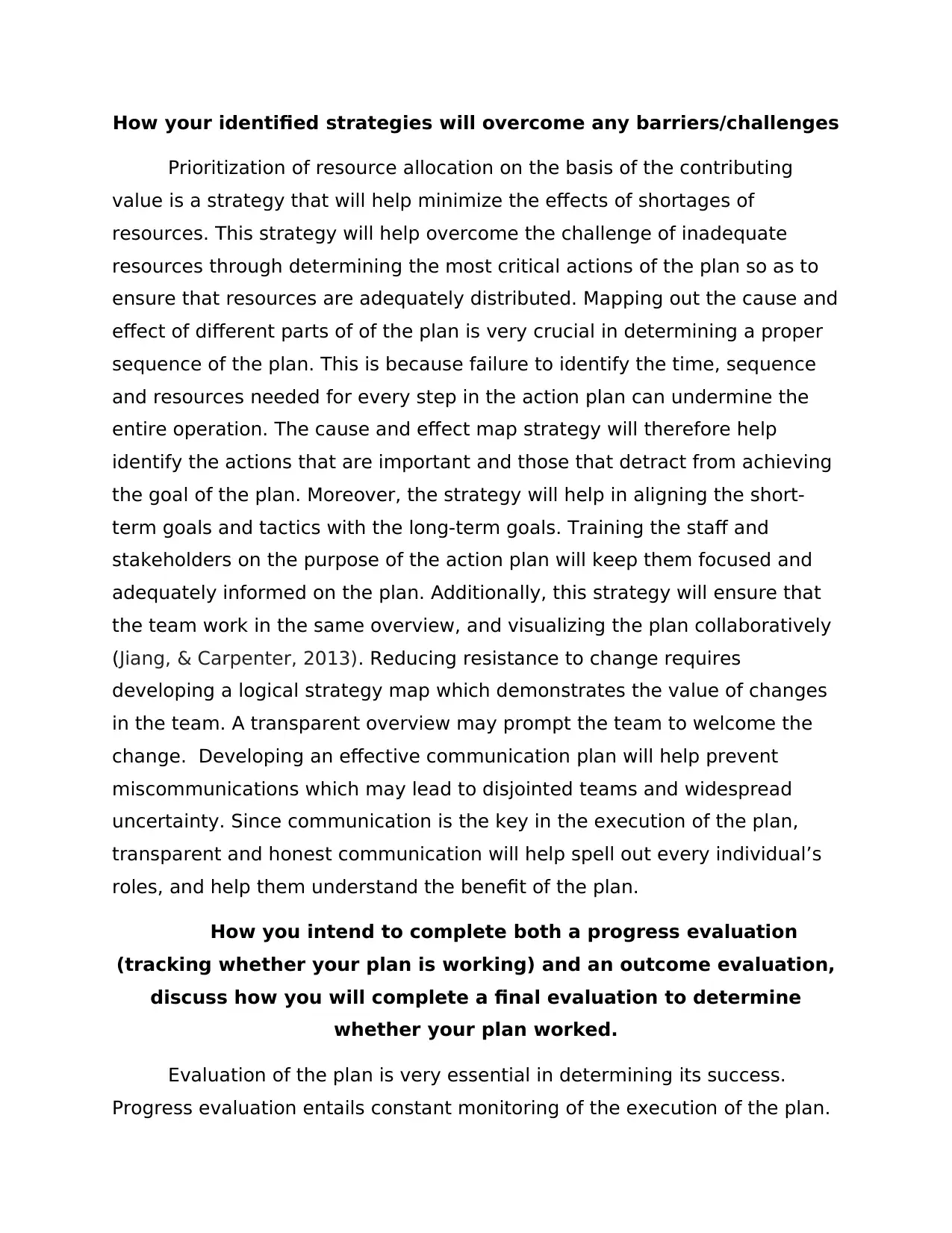
How your identified strategies will overcome any barriers/challenges
Prioritization of resource allocation on the basis of the contributing
value is a strategy that will help minimize the effects of shortages of
resources. This strategy will help overcome the challenge of inadequate
resources through determining the most critical actions of the plan so as to
ensure that resources are adequately distributed. Mapping out the cause and
effect of different parts of of the plan is very crucial in determining a proper
sequence of the plan. This is because failure to identify the time, sequence
and resources needed for every step in the action plan can undermine the
entire operation. The cause and effect map strategy will therefore help
identify the actions that are important and those that detract from achieving
the goal of the plan. Moreover, the strategy will help in aligning the short-
term goals and tactics with the long-term goals. Training the staff and
stakeholders on the purpose of the action plan will keep them focused and
adequately informed on the plan. Additionally, this strategy will ensure that
the team work in the same overview, and visualizing the plan collaboratively
(Jiang, & Carpenter, 2013). Reducing resistance to change requires
developing a logical strategy map which demonstrates the value of changes
in the team. A transparent overview may prompt the team to welcome the
change. Developing an effective communication plan will help prevent
miscommunications which may lead to disjointed teams and widespread
uncertainty. Since communication is the key in the execution of the plan,
transparent and honest communication will help spell out every individual’s
roles, and help them understand the benefit of the plan.
How you intend to complete both a progress evaluation
(tracking whether your plan is working) and an outcome evaluation,
discuss how you will complete a final evaluation to determine
whether your plan worked.
Evaluation of the plan is very essential in determining its success.
Progress evaluation entails constant monitoring of the execution of the plan.
Prioritization of resource allocation on the basis of the contributing
value is a strategy that will help minimize the effects of shortages of
resources. This strategy will help overcome the challenge of inadequate
resources through determining the most critical actions of the plan so as to
ensure that resources are adequately distributed. Mapping out the cause and
effect of different parts of of the plan is very crucial in determining a proper
sequence of the plan. This is because failure to identify the time, sequence
and resources needed for every step in the action plan can undermine the
entire operation. The cause and effect map strategy will therefore help
identify the actions that are important and those that detract from achieving
the goal of the plan. Moreover, the strategy will help in aligning the short-
term goals and tactics with the long-term goals. Training the staff and
stakeholders on the purpose of the action plan will keep them focused and
adequately informed on the plan. Additionally, this strategy will ensure that
the team work in the same overview, and visualizing the plan collaboratively
(Jiang, & Carpenter, 2013). Reducing resistance to change requires
developing a logical strategy map which demonstrates the value of changes
in the team. A transparent overview may prompt the team to welcome the
change. Developing an effective communication plan will help prevent
miscommunications which may lead to disjointed teams and widespread
uncertainty. Since communication is the key in the execution of the plan,
transparent and honest communication will help spell out every individual’s
roles, and help them understand the benefit of the plan.
How you intend to complete both a progress evaluation
(tracking whether your plan is working) and an outcome evaluation,
discuss how you will complete a final evaluation to determine
whether your plan worked.
Evaluation of the plan is very essential in determining its success.
Progress evaluation entails constant monitoring of the execution of the plan.
Paraphrase This Document
Need a fresh take? Get an instant paraphrase of this document with our AI Paraphraser
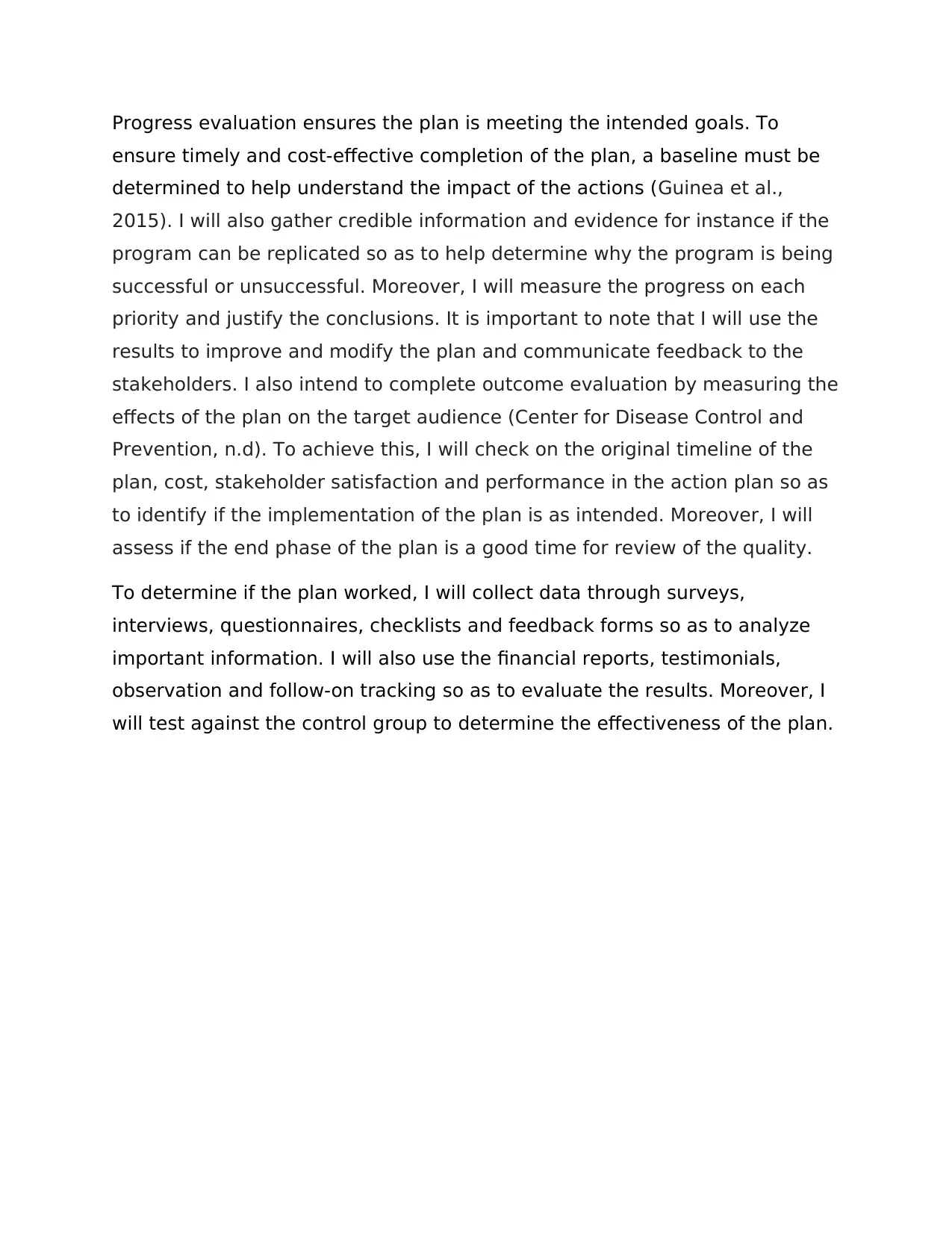
Progress evaluation ensures the plan is meeting the intended goals. To
ensure timely and cost-effective completion of the plan, a baseline must be
determined to help understand the impact of the actions (Guinea et al.,
2015). I will also gather credible information and evidence for instance if the
program can be replicated so as to help determine why the program is being
successful or unsuccessful. Moreover, I will measure the progress on each
priority and justify the conclusions. It is important to note that I will use the
results to improve and modify the plan and communicate feedback to the
stakeholders. I also intend to complete outcome evaluation by measuring the
effects of the plan on the target audience (Center for Disease Control and
Prevention, n.d). To achieve this, I will check on the original timeline of the
plan, cost, stakeholder satisfaction and performance in the action plan so as
to identify if the implementation of the plan is as intended. Moreover, I will
assess if the end phase of the plan is a good time for review of the quality.
To determine if the plan worked, I will collect data through surveys,
interviews, questionnaires, checklists and feedback forms so as to analyze
important information. I will also use the financial reports, testimonials,
observation and follow-on tracking so as to evaluate the results. Moreover, I
will test against the control group to determine the effectiveness of the plan.
ensure timely and cost-effective completion of the plan, a baseline must be
determined to help understand the impact of the actions (Guinea et al.,
2015). I will also gather credible information and evidence for instance if the
program can be replicated so as to help determine why the program is being
successful or unsuccessful. Moreover, I will measure the progress on each
priority and justify the conclusions. It is important to note that I will use the
results to improve and modify the plan and communicate feedback to the
stakeholders. I also intend to complete outcome evaluation by measuring the
effects of the plan on the target audience (Center for Disease Control and
Prevention, n.d). To achieve this, I will check on the original timeline of the
plan, cost, stakeholder satisfaction and performance in the action plan so as
to identify if the implementation of the plan is as intended. Moreover, I will
assess if the end phase of the plan is a good time for review of the quality.
To determine if the plan worked, I will collect data through surveys,
interviews, questionnaires, checklists and feedback forms so as to analyze
important information. I will also use the financial reports, testimonials,
observation and follow-on tracking so as to evaluate the results. Moreover, I
will test against the control group to determine the effectiveness of the plan.

References
Center for Disease Control and Prevention. (n.d). Types of evaluation.
Retieved from https://www.cdc.gov/std/Program/pupestd/Types%20of
%20Evaluation.pdf
Guinea, J., Sela, E., Gomez-Nunez, A. J., Mangwende, T., Ambali, A., Ngum,
N., ... & Srivanichakorn, S. (2015). Impact oriented monitoring: A new
methodology for monitoring and evaluation of international public
health research projects. Research Evaluation, 24(2), 131-145.
Jiang, N., & Carpenter, V. (2013). A case study of issues of strategy
implementation in internationalization of higher
education. International Journal of Educational Management, 27(1), 4-
18. https://doi.org/10.1108/09513541311289792
Mogobe, K. D., Shaibu, S., Matshediso, E., Sabone, M., Ntsayagae, E.,
Nicholas, P. K., ... & Webel, A. (2016). Language and culture in health
literacy for people living with HIV: perspectives of health care providers
and professional care team members. AIDS research and
treatment, 2016.
Center for Disease Control and Prevention. (n.d). Types of evaluation.
Retieved from https://www.cdc.gov/std/Program/pupestd/Types%20of
%20Evaluation.pdf
Guinea, J., Sela, E., Gomez-Nunez, A. J., Mangwende, T., Ambali, A., Ngum,
N., ... & Srivanichakorn, S. (2015). Impact oriented monitoring: A new
methodology for monitoring and evaluation of international public
health research projects. Research Evaluation, 24(2), 131-145.
Jiang, N., & Carpenter, V. (2013). A case study of issues of strategy
implementation in internationalization of higher
education. International Journal of Educational Management, 27(1), 4-
18. https://doi.org/10.1108/09513541311289792
Mogobe, K. D., Shaibu, S., Matshediso, E., Sabone, M., Ntsayagae, E.,
Nicholas, P. K., ... & Webel, A. (2016). Language and culture in health
literacy for people living with HIV: perspectives of health care providers
and professional care team members. AIDS research and
treatment, 2016.
⊘ This is a preview!⊘
Do you want full access?
Subscribe today to unlock all pages.

Trusted by 1+ million students worldwide
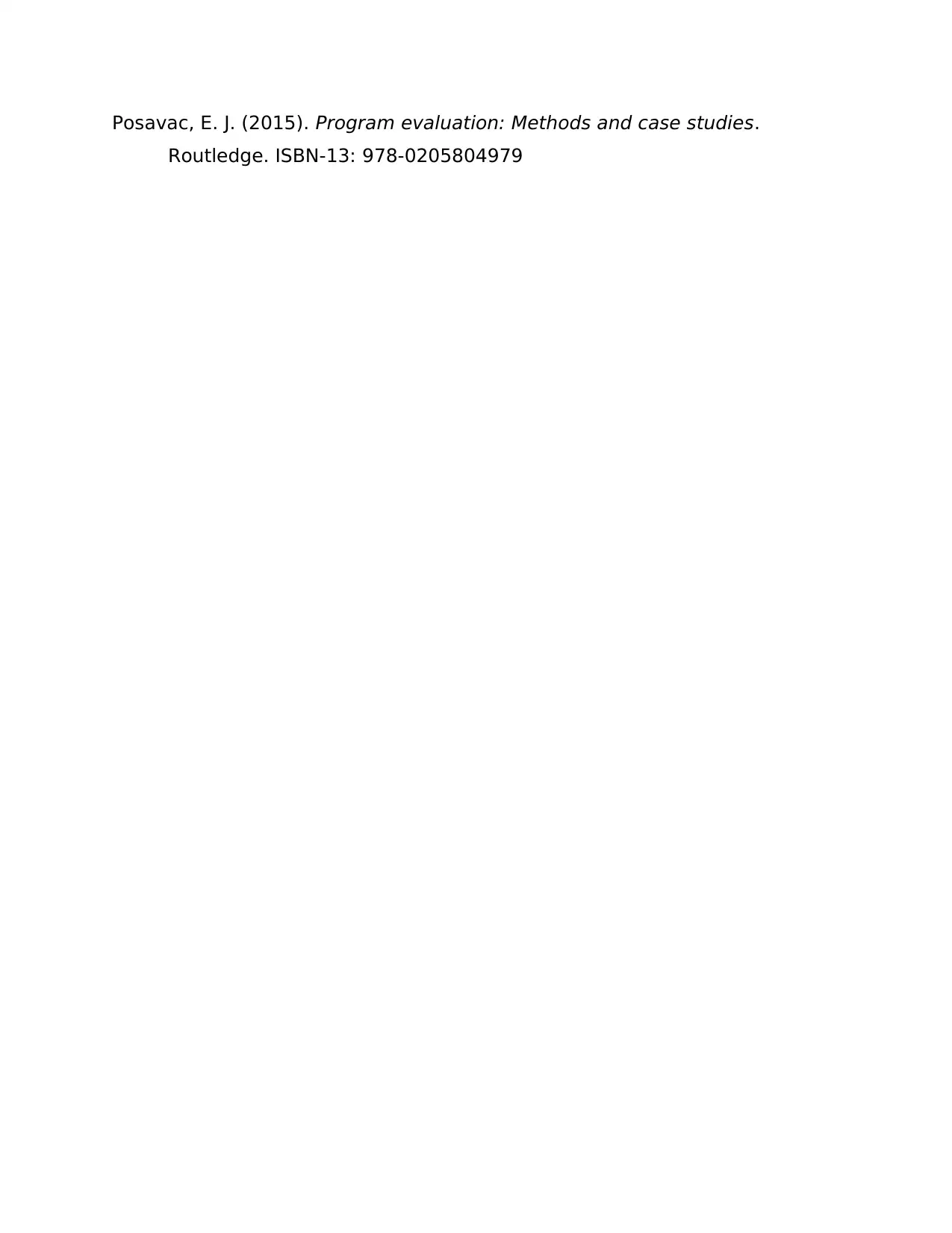
Posavac, E. J. (2015). Program evaluation: Methods and case studies.
Routledge. ISBN-13: 978-0205804979
Routledge. ISBN-13: 978-0205804979
1 out of 10
Your All-in-One AI-Powered Toolkit for Academic Success.
+13062052269
info@desklib.com
Available 24*7 on WhatsApp / Email
![[object Object]](/_next/static/media/star-bottom.7253800d.svg)
Unlock your academic potential
Copyright © 2020–2025 A2Z Services. All Rights Reserved. Developed and managed by ZUCOL.